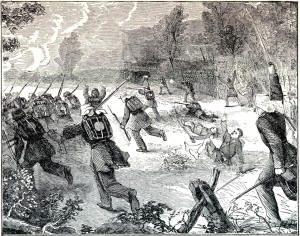|
The roads through these gaps were fortified.
At the same time ex-Governor H. A. Wise, with the commission of a
brigadier-general, was organizing a brigade in the Great Ranawha Valley,
beyond the Greenbrier Mountains. He was ordered to cross the intervening
mountains, and cooperate with Garnett.
General McClellan took command of his
troops in western Virginia, at Grafton, towards the close of May, and the
entire force of Ohio, Indiana, and Virginia troops under his control
numbered full 20,000 men. With these he advanced against the Confederates.
He sent Gen. J. D. Cox with a detachment to keep Wise in check, while with
his main body, about 10,000 strong, he moved to attack Garnett at Laurel
Hill, near Beverly. At the same time a detachment 4,000 strong, under
General Morris, moved towards Beverly by way of
Philippi, while another
body, led by General Hill, was sent to West Union, to prevent the escape of
any Confederates by that way over the Allegheny Mountains, to join Johnston
at Winchester. Garnett was then strongly
entrenched at Laurel Hill, with about 8,000 Virginians. Georgians,
Tennesseeans, and Carolinians. To this camp, Morris nearly penetrated, but
not to attack it—only to make feints to divert Garnett while
McClellan
should gain his rear. There was almost daily heavy skirmishing, chiefly by
Colonels Dumont and Milroy, on the part of the Nationals. So industrious and
bold had been the scouts, that when
McClellan appeared they gave him full
information of the region and the forces there. During a few clays, so
daring had been the conduct of the Nationals that they were regarded almost
with awe by the Confederates. They called the 9th Indiana—whose exploits
were particularly notable —" Swamp Devils." While on the road towards
Beverly, McClellan ascertained that about 1,500 Confederates under Col. John Pegram, were occupying a heavily entrenched position in the rear of Garnett,
in the Rich Mountain Gap, and commanding the road over the mountains to
Staunton, the chief highway to southern Virginia. Pegram boasted that his
position could not be turned; but it was turned by Ohio and Indiana
regiments and some cavalry, all under the command of Colonel Rosecrans,
accompanied by Colonel Lander, who was with Dumont at Philippi. They made a
detour, July 11, 1861, in a heavy rainstorm, over most perilous ways among
the mountains for about 8 miles, and at noon were on the summit of Rich
Mountain, high above Pegram's camp, and a mile from it.
Rosecrans thought his movement was unknown to the Confederates. Pegram was
informed of it, and sent out 900 men, with two
cannon, up the mountain road,
to meet the Nationals, and just as they struck the Staunton road the latter
were fiercely assailed. Rosecrans was without cannon. He sent forward his
skirmishers: and while these were engaged in fighting, his main body was
concealed. Finally Pegram's men came out from their works and charged across
the road, when the Indianians sprang to their feet, fired, and, with a wild
shout, sprang upon the foe with fixed bayonets. A sharp conflict ensued,
when the Confederates gave way, and fled in great confusion down the
declivities of the mountain to Pegram's camp. The battle lasted about an
hour and a half. The number of Union troops engaged was about 1,800, and
those of the Confederates half that number. The former lost 18 killed and
about 40 wounded; the latter 140 killed and a large number wounded and made
prisoners. Their entire loss was about 400. For his gallantry on this
occasion, Rosecrans was made a brigadier-general.
Garnett was a prey to the Nationals. In light marching order he pushed on
towards Beverly, hoping to escape over the mountains towards Staunton. He
was too late, for McClellan moved rapidly to Beverly. Garnett then turned
back, and, taking a road through a gap at Leedsville, plunged into the wild
mountain regions of the Cheat Range, taking with him only one cannon. His
reserves at Beverly fled over the mountains. Meanwhile Rosecrans had entered
Pegram's deserted camp, while the latter, dispirited and weary, with about
600 followers, was trying to escape. He surrendered to McClellan July 14. |
